
- ChatGPT - Home
- ChatGPT - Fundamentals
- ChatGPT - Getting Started
- ChatGPT - How It Works
- ChatGPT - Prompts
- ChatGPT - Competitors
- ChatGPT - For Content Creation
- ChatGPT - For Marketing
- ChatGPT - For Job Seekers
- ChatGPT - For Code Writing
- ChatGPT - For SEO
- ChatGPT - For Business
- ChatGPT - Machine Learning
- ChatGPT - Generative AI
- ChatGPT - Build a Chatbot
- ChatGPT - Plugin
- ChatGPT - GPT-4o (Omni)
- ChatGPT in Excel
- ChatGPT for Test Automation
- ChatGPT on Android
- Make Money with ChatGPT
- ChatGPT for UI/UX Designers
- ChatGPT for Web Developers
- ChatGPT for Data Scientists
- ChatGPT for Bloggers
- ChatGPT for Personal Finance Management
- Automate Customer Support with ChatGPT
- Create Content Calendars with ChatGPT
- Plan Events and Trips with ChatGPT
- Draft Legal Documents with ChatGPT
- Improve Your Coding Skills with ChatGPT
- New Language with ChatGPT
- Optimize ChatGPT Responses for Better Accuracy
- ChatGPT Useful Resources
- ChatGPT - Quick Guide
- ChatGPT - Useful Resources
- ChatGPT - Discussion
Create Content Calendars with ChatGPT
A content calendar enables you to systematically organize, plan, and schedule content across various platforms. Utilizing ChatGPT can improve this process by helping you generate ideas, structure your posts, and automate your scheduling tasks. This tutorial will take you through the essential steps to develop a thorough content calendar with the support of ChatGPT.
Step 1: Define Your Content Goals
Before creating a content calendar, it's essential to set clear goals. You can turn to ChatGPT for assistance with this task:
Use the following Prompt −
"Help me define content goals for my brand. I want to focus on increasing engagement and brand awareness."
ChatGPT might suggest these ideas:
- Involve your audience with interactive content.
- Improve brand visibility by producing educational material.
- Attract visitors to your website with SEO-driven articles.
- Generate leads through persuasive call-to-action posts.
- Establish yourself as a thought leader in your industry.
- Foster trust in your brand by highlighting success stories.
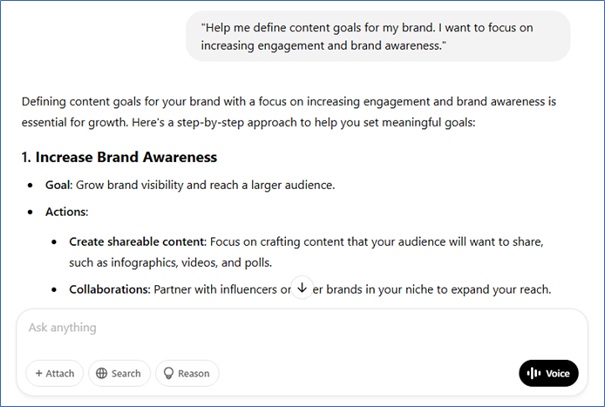
Step 2: Identify Content Categories
To create a thorough content calendar, begin by determining specific content categories. You can spark ideas using ChatGPT by posing questions like −
Use the following Prompt −
"Can you suggest content categories for a digital marketing blog?"
Consider the following categories −
- Educational − This includes how-to articles, tutorials, and insights into the industry.
- Promotional − Use this category to highlight product updates, current promotions, and announcements of sales.
- Engagement − Incorporate interactive features such as polls, Q&A sessions, contests, and live events to boost audience involvement.
- User-Generated Content − Showcase testimonials, case studies, and input from your audience.
- Seasonal/Trending Topics − Concentrate on campaigns tied to holidays, popular trends, and crucial industry news.
- Behind-the-Scenes − Offer a look at your company culture, share employee experiences, and reveal daily operations.
- Evergreen Content − Produce articles that remain relevant and valuable over time.
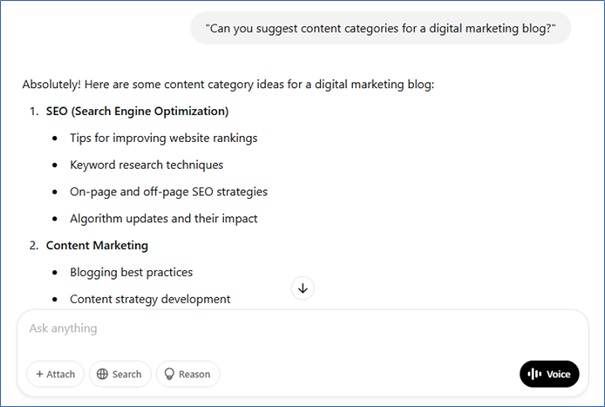
Step 3: Generate Content Ideas
Once you set categories, take the help of ChatGPT to generate post ideas.
Use the following Prompt −
"Give me 20 content ideas for a technology blog."
Example responses −
- "The Future of AI in Marketing"
- "How to Optimize Your Website for SEO in 2025"
- "Top 5 Cybersecurity Threats for Businesses"
- "Beginner’s Guide to Cloud Computing"
- "How Quantum Computing Will Change the Tech Industry"
- "Must-Have Productivity Apps for Remote Workers"
- "Comparing the Best Web Hosting Services"
- "AI vs. Human Creativity: Who Wins?"
- "How to Secure Your IoT Devices"
- "The Best Programming Languages to Learn in 2025"
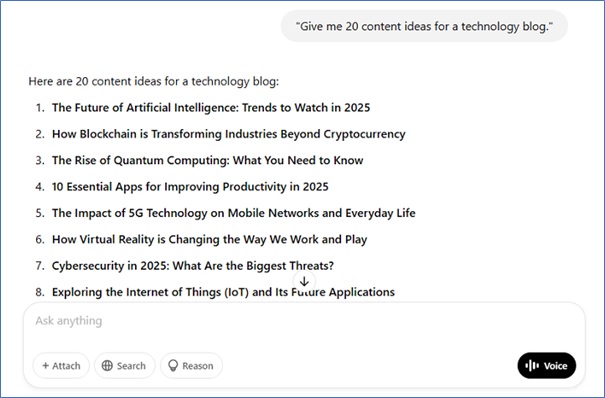
Step 4: Create a Content Calendar Template
A structured content calendar helps you track content schedules more easily. Use ChatGPT to create a template. Use the following Prompt −
"Provide a simple content calendar template."
Example template columns −
- Date (The day the content will be published)
- Content Title (Title of the article)
- Category (Informational, Advertising, etc.)
- Platform (Blog, Instagram, LinkedIn, etc.)
- Content Format (Text, video, infographic, etc.)
- Status (Draft, Scheduled, Published, Archived)
- Assigned to (Person responsible for the content)
- Notes (Additional instructions or references)
Use Google Sheets, Excel, or project management tools like Trello, Asana, or Notion to manage your calendar.
Benefits of Using a Template
Using a structured template helps you maintain consistency, track deadlines, and assign accountability.
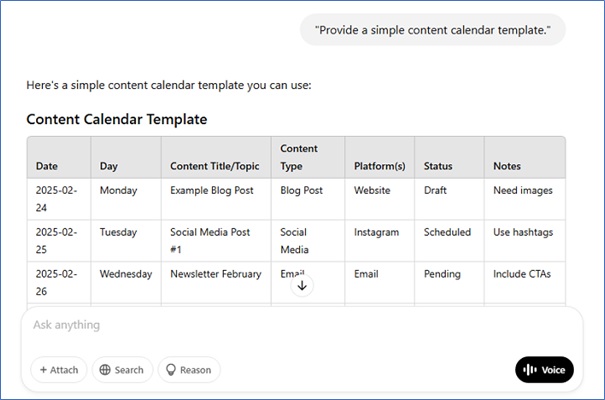
Step 5: Schedule Content Strategically
After you establish your calendar, tailor your content schedule next. You can use ChatGPT to suggest the best posting frequency that boosts engagement. Use the following Prompt −
"How often should I post on different social media platforms for maximum engagement?"
Best Posting Frequency for Various Social Media Platforms −
- Instagram − Post 3-5 times weekly
- LinkedIn − Post 2-3 times weekly
- Facebook − Post 3-4 times weekly
- Twitter/X − Tweet 5-7 times weekly
- YouTube − Upload 1-2 videos weekly
- Blog − Write 1-2 articles weekly
- TikTok − Post 4-7 times weekly
Why Posting Frequency Matters?
Posting too frequently can overwhelm your audience, while infrequent posting may lead to diminished visibility. Aim for a balanced strategy that aligns with your engagement metrics.
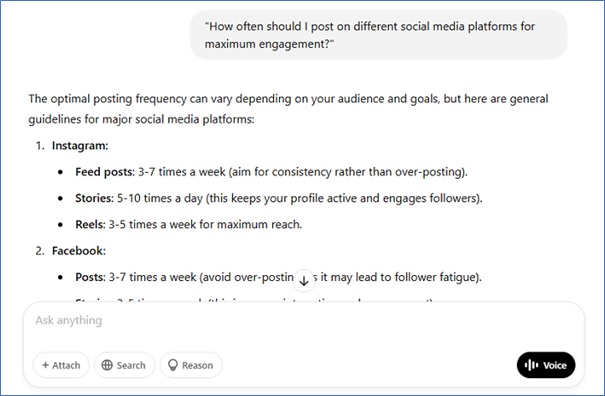
Step 6: Automate Scheduling
To ensure consistency, use scheduling tools actively.
Use the following Prompt −
"What are the best tools for automating social media posts?"
Suggested tools −
- Buffer (Social media scheduling and analytics)
- Hootsuite serves as an all-in-one social media management tool.
- Later excels at scheduling for Instagram.
- Sprout Social provides advanced analytics and facilitates team collaboration.
- CoSchedule automates content marketing and workflow processes.
Setting up Automation −
- Upload content to the scheduling tool.
- Set the dates and times for publishing.
- Enable auto-posting and reminders.
- Monitor the scheduled content for updates.
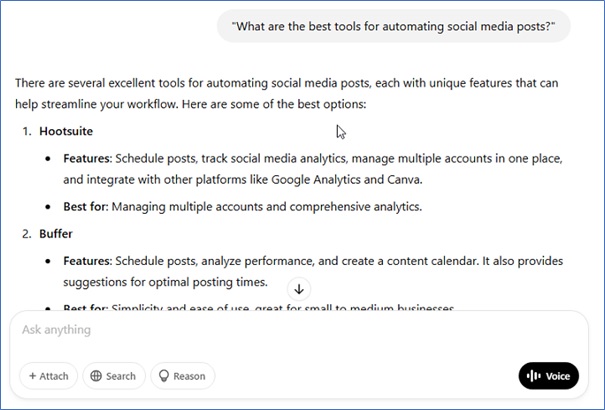
Step 7: Track Performance and Optimize
To refine your strategy, monitor content performance.
Use the following Prompt −
"How can I analyze my content performance?"
ChatGPT might suggest these ideas −
- Engagement Metrics − Track likes, shares, comments, and saves.
- Website Analytics − Use Google Analytics to measure traffic.
- Conversion Rate − Monitor lead generation and sales.
- Audience Insights − Check demographics and behavioral patterns.
Leveraging Data to Enhance Your Content Strategy
If your engagement levels are lacking, explore various formats, posting schedules, and subject matters. Use A/B testing to discover what appeals most to your audience.

Step 8: Repurpose and Recycle Content
Repurpose posts to maximize content value. Use the following Prompt −
"How can I repurpose my blog posts for different platforms?"
ChatGPT may present the following ideas −
- Convert blog articles into LinkedIn posts.
- Summarize key points in a Twitter thread.
- Create Instagram carousels with blog highlights.
- Turn data-heavy posts into infographics.
- Transform blog sections into short-form videos.
- Compile multiple articles into an eBook or whitepaper.
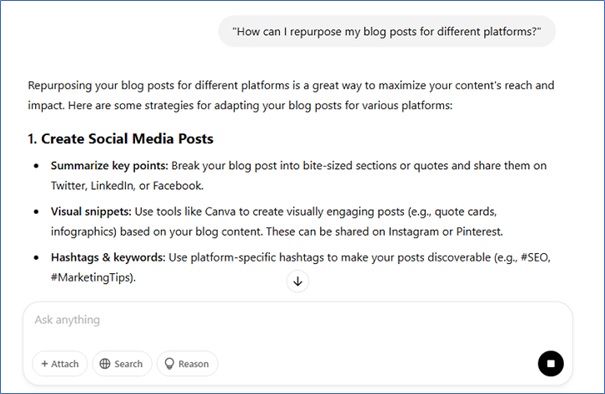
Step 9: Collaborate with Your Team
When collaborating with a team, it's important to designate roles and responsibilities. You can also utilize ChatGPT to help develop workflows.
Use the following Prompt −
"Suggest a workflow for a content marketing team."
Workflow Example −
- The Content Strategist plans topics and campaigns.
- Writers draft content.
- Editors proofread and refine content.
- Designers create visuals and graphics.
- Social Media Managers schedule and publish content.
- Analysts measure performance and provide insights.
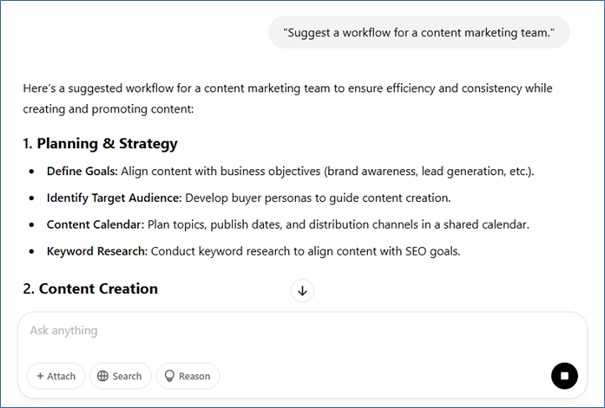
Conclusion
A well-planned content calendar ensures consistency, efficiency, and engagement. ChatGPT simplifies the process by generating ideas, structuring schedules, automating tasks, and optimizing performance. By following these steps, youll create a data-driven content strategy that drives meaningful results.
Implement these strategies to enhance your content marketing efforts and build a strong online presence.